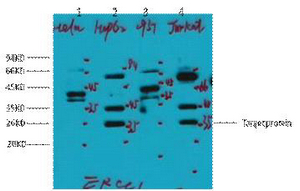ERCC1 Monoclonal Antibody(1B10)
- Catalog No.:YM3078
- Applications:WB;IHC;IF;
- Reactivity:Human
- Target:
- ERCC1
- Fields:
- >>Platinum drug resistance;>>Nucleotide excision repair;>>Fanconi anemia pathway
- Gene Name:
- ERCC1
- Protein Name:
- DNA excision repair protein ERCC-1
- Human Gene Id:
- 2067
- Human Swiss Prot No:
- P07992
- Mouse Gene Id:
- 13870
- Mouse Swiss Prot No:
- P07903
- Immunogen:
- Synthetic Peptide of ERCC1
- Specificity:
- The antibody detects endogenous ERCC1 proteins.
- Formulation:
- PBS, pH 7.4, containing 0.5%BSA, 0.02% sodium azide as Preservative and 50% Glycerol.
- Source:
- Monoclonal, Mouse
- Dilution:
- IHC: 100-300.WB 1:1000. IF 1:50-200
- Purification:
- The antibody was affinity-purified from mouse ascites by affinity-chromatography using specific immunogen.
- Storage Stability:
- -15°C to -25°C/1 year(Do not lower than -25°C)
- Other Name:
- ERCC1;DNA excision repair protein ERCC-1
- Observed Band(KD):
- 36kD
- Background:
- The product of this gene functions in the nucleotide excision repair pathway, and is required for the repair of DNA lesions such as those induced by UV light or formed by electrophilic compounds including cisplatin. The encoded protein forms a heterodimer with the XPF endonuclease (also known as ERCC4), and the heterodimeric endonuclease catalyzes the 5' incision in the process of excising the DNA lesion. The heterodimeric endonuclease is also involved in recombinational DNA repair and in the repair of inter-strand crosslinks. Mutations in this gene result in cerebrooculofacioskeletal syndrome, and polymorphisms that alter expression of this gene may play a role in carcinogenesis. Multiple transcript variants encoding different isoforms have been found for this gene. The last exon of this gene overlaps with the CD3e molecule, epsilon associated protein ge
- Function:
- disease:Defects in ERCC1 are the cause of cerebro-oculo-facio-skeletal syndrome type 4 (COFS4) [MIM:610758]. COFS is a degenerative autosomal recessive disorder of prenatal onset affecting the brain, eye and spinal cord. After birth, it leads to brain atrophy, hypoplasia of the corpus callosum, hypotonia, cataracts, microcornea, optic atrophy, progressive joint contractures and growth failure. Facial dysmorphism is a constant feature. Abnormalities of the skull, eyes, limbs, heart and kidney also occur.,function:Structure-specific DNA repair endonuclease responsible for the 5'-incision during DNA repair.,similarity:Belongs to the ERCC1/RAD10/SWI10 family.,subunit:Heterodimer composed of ERCC1 and XPF/ERRC4.,
- Subcellular Location:
- [Isoform 1]: Nucleus .; [Isoform 2]: Cytoplasm . Nucleus .; [Isoform 3]: Nucleus .; [Isoform 4]: Nucleus .
- Expression:
- Cerebellum,Lung,Ovarian cancer,Uterus,
- June 19-2018
- WESTERN IMMUNOBLOTTING PROTOCOL
- June 19-2018
- IMMUNOHISTOCHEMISTRY-PARAFFIN PROTOCOL
- June 19-2018
- IMMUNOFLUORESCENCE PROTOCOL
- September 08-2020
- FLOW-CYTOMEYRT-PROTOCOL
- May 20-2022
- Cell-Based ELISA│解您多样本WB检测之困扰
- July 13-2018
- CELL-BASED-ELISA-PROTOCOL-FOR-ACETYL-PROTEIN
- July 13-2018
- CELL-BASED-ELISA-PROTOCOL-FOR-PHOSPHO-PROTEIN
- July 13-2018
- Antibody-FAQs
- Products Images

- Western blot analysis of 1) Hela, 2) HepG2, 3) 293T, 4) Jurkat, diluted at 1:2000. cells nucleus extracted by Minute TM Cytoplasmic and Nuclear Fractionation kit (SC-003,Inventbiotech,MN,USA).

- Immunohistochemical analysis of paraffin-embedded human tonsil. 1, Tris-EDTA,pH9.0 was used for antigen retrieval. 2 Antibody was diluted at 1:200(4° overnight.3,Secondary antibody was diluted at 1:200(room temperature, 45min).



